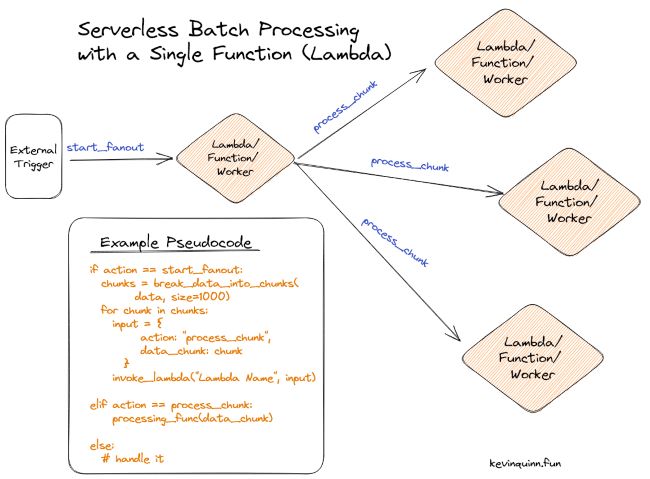Serverless Design Pattern for Batch Processing with Fan Out
This is a simple serverless design pattern that has come in handy numerous times during my career. The problem: I need to process a large amount of data through a Lambda and am running into timeouts even at 15 minutes - or maybe I just need the process to hurry itself along.
Serverless Batch Processing 🔗︎
The design pattern only requires a single Lambda, with a conditional variable in the input that chooses how the Lambda will behave. It will either operate as A) the fan-out orchestrator, or B) process a single item/batch.

The pseudocode from the photo is repeated below:
action = input["action"] or "process_chunk"
if action == "start_fanout":
chunks = break_data_into_chunks(
data, size=1000)
for chunk in chunks:
input = {
action: "process_chunk",
data_chunk: chunk
}
invoke_lambda("Lambda Name", input)
elif action == "process_chunk":
processing_func(data_chunk)
else:
# handle it
In the example, action is our key conditional trigger.
Variations 🔗︎
There’s a few different ways you can vary the pattern to suit your needs. When input is first received to the start_fanout worker, it can either be passed as part of the input or just be used as the signal for the worker to go collect that information.
In the same vein, sometimes it makes sense to pull all the data and chunk it before passing it to process_chunk, other times you can pass something like an ID so the processor knows where to pull the data it has to act on.
Requirements 🔗︎
You’ll need to have a way (and permissions!) to recursively invoke your function for this pattern to be an option. If on AWS, that might be **lambda:InvokeFunction **in the IAM role. A more widely usable pattern is available if your function sits behind an API - just make a request! Even the bare bones function runtimes provide the ability to make HTTP requests.
See Also
- Tiny Python Router for AWS Lambda APIs
The utility of Python Flask routing on a Lambda, without the framework.
- Code Pattern: Separating Decisions and Actions
Making my code easier to unit test by separating the decision-making logic from the actions it initiates.
- How to be Annoying with CSS Cursors (and a sprinkle of JS)
Emoji cursors changing based on position? Oh my.
- Add a Random Page Button to Hugo Site
Let users read a random page on your site. A quick guide on how to add this feature to your site in no time.
- Python Parse RSS Feed With No Dependencies
Parsing RSS with Python standard library.